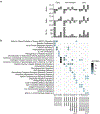Integrating Multi-Omics with environmental data for precision health: A novel analytic framework and case study on prenatal mercury induced childhood fatty liver disease
- PMID: 39128376
- PMCID: PMC11620538
- DOI: 10.1016/j.envint.2024.108930
Integrating Multi-Omics with environmental data for precision health: A novel analytic framework and case study on prenatal mercury induced childhood fatty liver disease
Abstract
Background: Precision Health aims to revolutionize disease prevention by leveraging information across multiple omic datasets (multi-omics). However, existing methods generally do not consider personalized environmental risk factors (e.g., environmental pollutants).
Objective: To develop and apply a precision health framework which combines multiomic integration (including early, intermediate, and late integration, representing sequential stages at which omics layers are combined for modeling) with mediation approaches (including high-dimensional mediation to identify biomarkers, mediation with latent factors to identify pathways, and integrated/quasi-mediation to identify high-risk subpopulations) to identify novel biomarkers of prenatal mercury induced metabolic dysfunction-associated fatty liver disease (MAFLD), elucidate molecular pathways linking prenatal mercury with MAFLD in children, and identify high-risk children based on integrated exposure and multiomics data.
Methods: This prospective cohort study used data from 420 mother-child pairs from the Human Early Life Exposome (HELIX) project. Mercury concentrations were determined in maternal or cord blood from pregnancy. Cytokeratin 18 (CK-18; a MAFLD biomarker) and five omics layers (DNA Methylation, gene transcription, microRNA, proteins, and metabolites) were measured in blood in childhood (age 6-10 years).
Results: Each standard deviation increase in prenatal mercury was associated with a 0.11 [95% confidence interval: 0.02-0.21] standard deviation increase in CK-18. High dimensional mediation analysis identified 10 biomarkers linking prenatal mercury and CK-18, including six CpG sites and four transcripts. Mediation with latent factors identified molecular pathways linking mercury and MAFLD, including altered cytokine signaling and hepatic stellate cell activation. Integrated/quasi-mediation identified high risk subgroups of children based on unique combinations of exposure levels, omics profiles (driven by epigenetic markers), and MAFLD.
Conclusions: Prenatal mercury exposure is associated with elevated liver enzymes in childhood, likely through alterations in DNA methylation and gene expression. Our analytic framework can be applied across many different fields and serve as a resource to help guide future precision health investigations.
Keywords: Bioinformatics; Biomarkers; Epigenetics; Multiomics; Precision health; Prenatal exposures.
Copyright © 2024 The Authors. Published by Elsevier Ltd.. All rights reserved.
Conflict of interest statement
Declaration of competing interest The authors declare that they have no known competing financial interests or personal relationships that could have appeared to influence the work reported in this paper.
Figures






References
MeSH terms
Substances
Grants and funding
LinkOut - more resources
Full Text Sources
Medical
Research Materials

